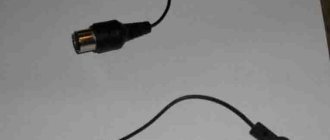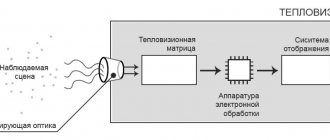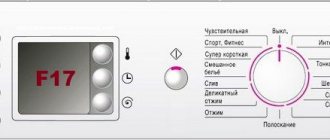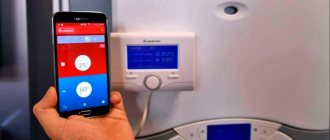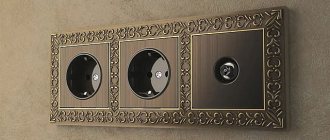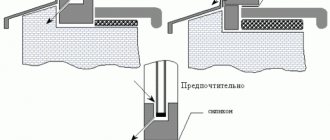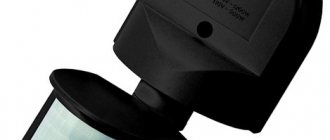Unlike terrestrial cable television, it is not received by an antenna from a television repeater, but is supplied by cable directly to the apartment. This method allows you to minimize signal loss and improve picture quality. Cable TV gives the operator the opportunity to independently regulate the number of channels, their format and encoding method. Cable TV provides subscribers with dozens and even hundreds of channels, both in analog and digital quality. Determining that you have cable TV is quite simple:
if your TV receives more than 20 channels, you are watching cable TV.
Typically, cable operators, to minimize financial losses, calculate the signal level as one TV per apartment. As a result, when wiring cables to several TVs, you have to resort to the help of an amplifier.
Why is the digital TV signal weak?
All reasons for a weak signal level can be divided into two categories. These are reasons that can be influenced (on the viewer’s side) and factors that do not depend on the user of terrestrial television.
- The television tower is located very far from where television is viewed. Usually the problem is typical for country houses and dachas. There, a conventional antenna cannot provide a good signal, which is why the level is very low or almost zero. In this case, even if you connect an amplifier, it is unlikely to significantly increase the digital TV signal. Therefore, satellite dishes are more often installed in remote settlements from the city.
- Obstacles on the path of a television and radio signal . The digital DVB-T2 signal is broadcast in short waves, which travel over long distances, but cannot avoid obstacles. Therefore, any high opaque (concrete, reinforced concrete, hills, dense forests) structures prevent the signal from reaching all points. The TV signal can be reflected, but most often it is absorbed. If you live on a high floor, then in most cases the problem is unlikely. The reason is relevant specifically for the first floors, especially if an indoor antenna is used and tall, dense trees grow outside the window. Even leaves can be the reason why digital channels show poorly.
- Weather. Pure air does not affect the transmission of a television signal. But strong atmospheric phenomena can reduce the signal. This is especially true for fog.
- The signal does not come from the repeater, but from reflective surfaces. A common situation for highly dense buildings. Direct waves do not reach your structure, but are reflected from other walls. Consequently, part of the signal is lost, which is a consequence of a weak television signal.
- Bad antenna. If we talk about homemade digital antennas, then even a slight deviation from the required dimensions affects the reception quality. If a factory terrestrial receiver is installed, then it may be low-power. Or it works without an amplifier, which may be the reason specifically in your situation.
- Inaccurate targeting. You can only get a good level of DVB-T2 signal on a TV or set-top box if you tune the antenna as accurately as possible to the repeater. If we guide the structure manually, we will simply hit it at random. When installing, you need to take into account the exact directions given. Information is provided by the RTRS mapping service.
- Loss of television signal in the television circuit. This refers to a problem with the line (TV cable) that is laid from the antenna to the TV. Causes range from incorrect cables to poor connections and damage. A possible, but not so common reason is the excessive length of the television cable. The longer the TV wire, the greater the losses. With each meter of line, the signal attenuates by a certain amount. It is believed that the extreme value of a cable line for terrestrial TV is 100 m. With such a “path” the attenuation occurs almost to zero. And the first problems with the TV signal can begin already with a length of 15-20 m.
- Using a splitter when connecting several TVs to one antenna. A splitter, also known as a divider, reduces the signal at each of its outputs depending on their number. If you take a splitter with two outputs, then the value will be divided by two. Consequently, if initially the TV signal reached one TV receiver with a level of 70%, then after connecting the splitter the level will drop to 35%.
Based on the factors listed above, the actions that can be taken to amplify the TV signal from a digital TV antenna become clear.
What factors influence the deterioration of a TV signal?
Before studying radio engineering innovations, it is necessary to analyze why the level of functioning of the receiver is low. Causes of noise and poor image quality may include:
- significant distance of the home from the repeater;
- incorrect choice of television antenna;
- high level of natural noise;
- external obstacles to signal reception: high-rise buildings, trees, industrial buildings;
- cable failure;
- incorrect orientation of the transmitter;
- the presence of metal objects near the antenna that can conduct electricity;
- distribution of a television signal to several receivers;
- outdated technology.
How to boost your antenna signal
- Completely change the device. Especially if a homemade structure is connected. So in many cases it is possible to solve the problem with a poor TV signal. If you are going to buy a new decimeter antenna, immediately buy one with a built-in amplifier. When television is tuned through a set-top box, you don’t have to buy an external power supply for the amplifier. The digital set-top box itself can supply power via a coaxial cable. If the receiver is not used, then do not forget about the power supply unit, otherwise the system will not work (the TV does not power the coaxial wire).
- Adjust the T2 antenna, reinstall it in a new location, or simply change the direction.
- Connect the antenna amplifier. If you do not want to change the receiving device, you can enhance the operation of the device by connecting an external amplifier. Amplifiers vary in design and operating principle. The only thing worth knowing for now is that they will connect to the TV cable already inside the apartment or house. There are combined amplifiers, for example, with a built-in power supply, with several outputs for connecting multiple television receivers. Or use a regular mortise amplifier. The use of an amplifier can be a decisive element in strengthening the antenna signal.
- Diagnostics (external inspection and detailed check) of the television circuit. You need to inspect all kinds of line elements, from the antenna to the jack on the TV or external tuner. Inspect the cable connection to the antenna, other connection points, adapters, plugs, splitters. Also check the cable visually to see if there is any severe damage to the outer sheath, kinks or crushing by heavy, and even more so, sharp objects or furniture. If in doubt, remake the connections.
- Check the characteristic impedance of the cable with a multimeter, the value should be 75 Ohms. If the resistance is completely different, it is better to lay a new cable.
- Carefully consider the layout of the cable to the television receiver. Try to reduce the length as much as possible. Even a couple of meters of cable sometimes affect the overall quality of the television.
We need to talk in more detail about setting up the TV antenna and the amplifier. It is these two points that almost always help set digital TV images to the next level. Recommendations and instructions will help not only with working with an external (outdoor, outdoor) antenna. It will also be possible to strengthen the signal of an indoor antenna at home.
To avoid buying an amplifier (if a passive design works), it is better to first check the correct placement of the receiver. And if necessary, change the installation location and direction.
Advice from professionals
During the assembly and installation of the signal amplifier, it is necessary to take into account not only the recommendations of the manufacturers, but also follow the advice of professionals. They will help you avoid most simple mistakes and achieve the desired result in a minimum amount of time.
Key recommendations from experts:
- The antenna amplifier must be located in close proximity to the TV. This is done in order to reduce cable losses, which can cause deterioration in the quality of the television picture.
- It is not recommended to equip indoor antennas with signal amplifiers, as this will not provide any benefits and will not eliminate interference.
- Before using the device, be sure to study the included instructions in detail. This information will help you install the device correctly and reduce the likelihood of installation errors.
- If the installed amplifier does not solve the problem, then the cause of poor signal quality should be sought in the antenna itself, its location and correspondence to wave frequencies.
- Any installation, repair or maintenance work on the device should be carried out only after it has been disconnected from the power source. There is a high risk of electric shock.
- It is prohibited to connect the signal amplifier to antennas located on the roof of a building or in rooms not equipped with lightning protection. If you neglect this advice, you may lose not only the amplifier, but also the TV.
- Do not connect a device that has visible damage to the housing, as this will increase the risk of electric shock.
A TV signal amplifier is a useful and inexpensive device. With its help, you can eliminate various interference and significantly improve the quality of the television picture. With the right approach to choosing a device and following all the recommendations of professionals, you can achieve the desired result and reduce the likelihood of malfunctions.
Setting up a TV antenna
The whole setup consists of pointing the structure with its axis towards the signal transmitting station.
General installation recommendations
- If the houses are located parallel to each other, the best place to mount the antenna will be the end of the building or the roof.
- The higher the DVB-T2 receiver is mounted, the greater the chance that nothing will prevent the signal from reaching the antenna.
- It is better not to leave an extra piece of cable outside. Strong gusts of wind can loosen the cable and damage its contact with the antenna or amplifier. Therefore, you need to keep the cable taut, or at least not leave a dangling piece of wire loose.
How to correctly navigate to the signal source
- Open your digital TV card.
- In the “Address or location” field, enter the address where you want to set up the TV antenna. You can only specify a region with a city, but it is better to specify a district with a house number.
- After searching on the map, select the house you are looking for.
- A window with parameters for television broadcasters will appear.
- Using the “Distance” line, select a nearby tower from the two presented.
- The “Direction” line indicates the exact azimuth, and there is an arrow on the right. Based on the readings of the CETV map, with a compass in your hands, orient the antenna axis towards the signal translator.
This is enough to catch the signal at a fairly high level.
But problems may arise when following the instructions and after.
- The nearest tower is located on the back side of the apartment building. Then the antenna will be pointed at the wall. In this case, you need to choose a remote repeater or reinstall the structure on the other side. For example, sometimes they stretch a cable through a neighboring apartment.
- If the area is too densely built up and planted, then even the direct signal will be scattered. Often it is not possible to fit properly (higher or on the lid). Then the solution will be to connect to a collective common house antenna or try to amplify the T2 signal using an electronic amplifier. This will be discussed further.
Methods for amplifying TV antenna power
- Change the location of the antenna. As a rule, it is directed towards the transmission tower.
- Purchasing an antenna amplifier. They are electrical devices that connect directly to the antenna and provide an impetus to improve the received signal.
- Expand the number of antennas for a clearer image, installed at the highest place.
- Change the device to a more powerful TV antenna.
- Remove all objects and metal objects that may interfere with the reception of the TV signal.
- Check the television cable for integrity. In case of short circuits or breaks, replace it with a new one. For a high-quality signal, it is important to choose the right cable.
- Create the effect of a common-mode antenna array (CAR). It consists in the fact that identical receivers form a complex system that operates on a common matched load so that the signal phases are the same.
Knowing how to improve a television signal, you can reduce image noise on the screen to a minimum and enjoy high-quality viewing, regardless of the distance to the television center.
Antenna amplifier
What you need to know about amplifiers
Despite the obvious advantages of amplification devices, there are significant disadvantages.
Advantages:
- no need to purchase a new antenna (connecting the structure to an amplifier will lead to a significant increase in the signal);
- the length of the TV line can be neglected. In many cases, the power of the television signal increases so much that even a long television path will not interfere with the normal reception of channels.
List of disadvantages:
- Only a knowledgeable person can make an antenna amplifier with his own hands. Therefore, the device is almost always purchased separately. The cost is not so high that it will hit your pocket hard, but you will still have to spend some money. If the amplifier is not initially built into the structure, you will need to install it yourself. To do this, you will need to buy several more connectors for connecting to the amplifier, you need tools and at least the initial ability and desire to cope with the task.
- The operation of an amplifier is based not simply on amplification, but on copying the signal. Only an already amplified version of the original signal is created. The electronic signal can only be increased with external power. Therefore, the amplifier needs to connect a power supply. The easiest way is when DTV works through a T2 receiver. In the set-top box menu, you can enable the “Antenna power” option. Then there is no need for external power. The set-top box itself will power the amplifier via a coaxial feeder. If the terrestrial DTV setup is done directly on the TV, then you will have to use third-party power from outside. For this purpose, a power supply is purchased. Another power supply is a combination amplifier. The device already has a block inside the device body. Then you only need to connect with a cable from the DVB-T2 antenna.
- In a television coma, another signal may be received. In this case, interference and noise are meant. If the signal is not “clean”, the amplifier will also increase the noise level.
- Excessive amplification has a negative impact on the “digital”. If the TV signal level is high, using an amplification device may have a bad effect. The digital decoder on your TV or tuner will not process excessive TV signals. Therefore, it is always recommended to look towards using an amplifier with a regulator. An adjustable “valve” will allow you to get rid of “excessive” gain.
From the above, the conclusion suggests itself: the amplifier is justified only for a weak, but at the same time clean radio signal.
What to consider when choosing
If you watch only digital television, then you can safely take a universal amplifier for the DWM range. When using digital and analog television simultaneously, it is better to take a universal amplifier. This way you can enhance the reception of both types of TV broadcasts at the same time.
The best choice is always an antenna with a built-in amplifier. The device is a board (SWA), which is hidden in a plastic casing directly on the receiver.
But if you didn’t plan to change the antenna, you can’t do without an external device. Then there is only one parameter left to choose - the power type. There are two types: with direct power supply (Fig. below) and external. In most cases, the type with power supply via cable (external) is selected. Another option is also possible, it has much larger dimensions, and therefore more power. Power comes directly from the outlet through the network cable extending from the device.
Connection diagrams
Depends on the antenna (active or passive) and the equipment involved.
If the amplifier has built-in power
The scheme is distinguished by its simplicity. The user only needs to cut the TV cable into two parts in the area closest to the antenna in the room. Next, F-connectors are put on both ends of the cable. Then the connector on the TV cable leading from the receiving device is screwed onto the thread of the amplifier's input jack (INPUT). The other connector connects to the output port. Then the power cord is plugged into the outlet.
If you need to watch more than one TV, then a splitter with the required number of ports is connected between the TV receiver and the amplifier. The maximum permissible number of channels on one divider is limited to 8 pieces. But if necessary, you can connect several dividers in series. This way it will be possible to increase the number of connected equipment in one television system.
If the amplifier is without its own power supply
The connection diagram is no different from the previous one. The only difference is the need to connect the adapter powering the amplifier to the TV cable.
The connection is made through a separator - a signal-voltage separator. Since power and signal will be supplied through the same cable, mixing must be avoided. This task is performed by the separator.
Externally, the separator is a small box with an antenna plug. You need to disassemble the separator, strip the cable and secure it with bolts in the clamp on the board.
Next, the separator plug is inserted into the antenna input of the TV or set-top box.
If a splitter is used, the separator is connected through an adapter that is screwed onto the input of the divider.
You can also put a separator on any final section of the television circuit, i.e. at the input of the first, second or nth TV. Then the power must pass to the amplifier through a divider. Therefore, a voltage-passing device is required. You need a splitter with power supply.
This is true for any circuit where power is provided externally.
If an active antenna is connected
The system setup algorithm is no different from the previous scheme. Just don't cut into the amplifying device inside the line.
Recommendations for selection
So, how to strengthen the digital television signal? First you need to choose a good amplifier that will work in a particular case.
To begin with, find out in what range the broadcast is made in your region: it can be meter and decimeter. In the first case, the maximum frequency is 300 MHz, and in the second – 3 Hz.
Amplifiers are single-range, i.e. work only in one mode, and are universal with a switch. This is the main indicator that you should pay attention to.
However, it is also recommended to study the following:
- Reception range. The minimum range is 30 km, but 150 is better! The indicator indicates the distance between your receiver and the repeater point. It makes no sense to put everything below 30 km, because... there will be almost no effect. Anything more is wasteful, because... Such amplifiers are expensive.
- Reception gain factor. How to improve the signal? Of course, you need to look at how much the amplifier can increase reception. The rule here is: “The further away the repeater, the higher the coefficient.” For a distance of 50 km, a gain of 27 dB is sufficient, i.e. ratio: 1 dB at 1.85 km.
- Nutrition. Some models are powered by a power supply, others by a receiver. According to customer reviews, the first models work better. On the other hand, the latter are much more convenient, because You just need a long USB cable.
- Frame. Depends on the installation location. Models with a plastic body are suitable for indoor use, and metal ones for outdoor use.
TOP 4 good amplifier
1 Model SWA9001/999/9701 (L) broadband. A good broadband amplifier without adjustment. Suitable for both home installation and mast installation. It is recommended to install an additional metal screen. Capable of picking up a signal up to 100 km.
2 Televes. A good 5-output Italian amplifier with a gain of 15 dB. The signal increase is not very large, but excellent noise reduction is provided. Powered by the included power supply.
3 Gecen A05-02. Satellite and digital amplifier operating in both the meter and decimeter range. It is powered via a coaxial cable, which is not very good, but there is no need to purchase an additional power supply or USB.
4 RTM LNA02. An excellent model with a gain of 20 dB. It has excellent noise reduction and is powered by the receiver. Well suited for broadcast-restricted areas.
Do-it-yourself amplifying device: advantages and disadvantages
Important! It is much easier to buy digital television signal amplifiers online from Chinese manufacturers. Such a device is cheap, and its delivery will be free.
Only such things can encourage you to start making an amplifier yourself - this is the desire to make something of better quality, as well as improve your amateur radio skills. You won't be able to achieve big savings with this option.
Important! If a radio amateur plans to receive a digital signal, then in this case the receiver must be equipped with a “DVB-T2” digital tuner. Otherwise, you will have to purchase an additional receiver for your TV, with which you will be able to watch TV channels in the desired frequency range.
Reliability
Speaking about reliability, it must be said that this is an industrially manufactured antenna. It should be well secured to the mast and the cable leading to it should not dangle in the wind. If the amplifier is not installed on the antenna itself, then firmly attach it to some fixed support. Seal the box with the amplifier well from moisture or fill it with silicone. Do all this only after the final setup.
If the antenna with the simulator is placed above the roof, and the amplifier is placed below, under the roof, then this provides additional ease of maintenance, because periodically you need to look into the amplifier, clean the connections, and remove cobwebs from the box.
Location and connection
Speaking about homemade devices, they do not need to be connected to the roof. It is enough to simply attach the “homemade product” to the window (on the wall of the house), pointing it towards the tower.
The TV antenna is connected via a TV cable, attached on one side to the TV, on the other - to the structure itself. Next you need to go to the settings section by clicking on the “auto settings” button.
Satellite
Remember? We're talking about T2 terrestrial digital television, so forget about satellites. You will not receive terrestrial television in the DVB-T2 standard through a satellite tuner. You will not connect the T2 tuner to a satellite dish. We receive the T2 signal from the nearest broadcast tower in the UHF range. To a regular over-the-air antenna for a summer residence, not a “dish”.
